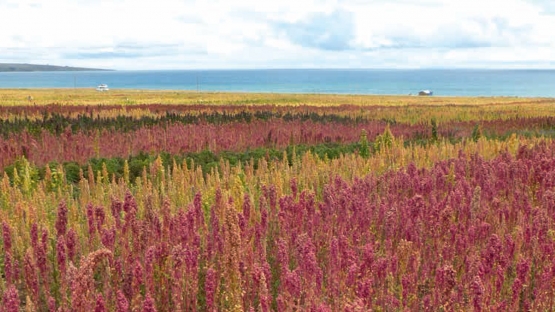In the battle to help developing countries overcome threats from declining food production caused by climate change, one species of edible grain-like crop has caught international attention because of its unique nutritional value. New and improved varieties of quinoa, historically grown in the highlands of South America, will be made available to farmers in mutations adapted to challenging environments in Bolivia and Peru.
Increased genetic diversity is the result of the use of nuclear techniques (see box) in collaboration with the IAEA and the Food and Agriculture Organization of the United Nations (FAO), said L. Gomez-Pando, Principal Professor and Head of the Cereals and Native Grains Research programme at the National Agrarian University of La Molina in Peru. “There are 64 mutant lines of quinoa selected by yield potential and quality for the market,” she said. “These mutant lines will be further evaluated and the best lines will be released as new varieties in 2015–2016.”
The use of new and high-yielding quinoa varieties will allow farmers to improve their income and increase their own protein intake, Gomez-Pando explained. The new varieties will provide seeds at affordable prices to people in danger of malnutrition, especially children below five years of age.
“Due to its high nutritional, agronomic and economic value, quinoa is set to be a major food for future generations and an important alternative crop, considering the challenges caused by climate change,” said Qu Liang, Director of the Joint FAO/IAEA Division of Nuclear Techniques in Food and Agriculture. Quinoa is now considered to be essential in efforts to tackle hunger, malnutrition and poverty.
Protecting and enhancing quinoa production using nuclear techniques
The Joint Division used advanced nuclear techniques to enable farmers in Latin America and elsewhere to further boost quinoa production. This was achieved through induced mutation and the detection of improved quinoa genotypes, which has resulted in the breeding of new quinoa varieties.
Quinoa has exceptional nutritional composition, with higher protein content than brown rice, barley and millet. Besides being gluten free, quinoa is an excellent source of dietary fibre and has elevated levels of phosphorus, magnesium, iron and calcium. It is also rich in vitamins.
Due to its high nutritional, agronomic and economic value, quinoa is set to be a major food for future generations and an important alternative crop considering the challenges caused by climate change.



